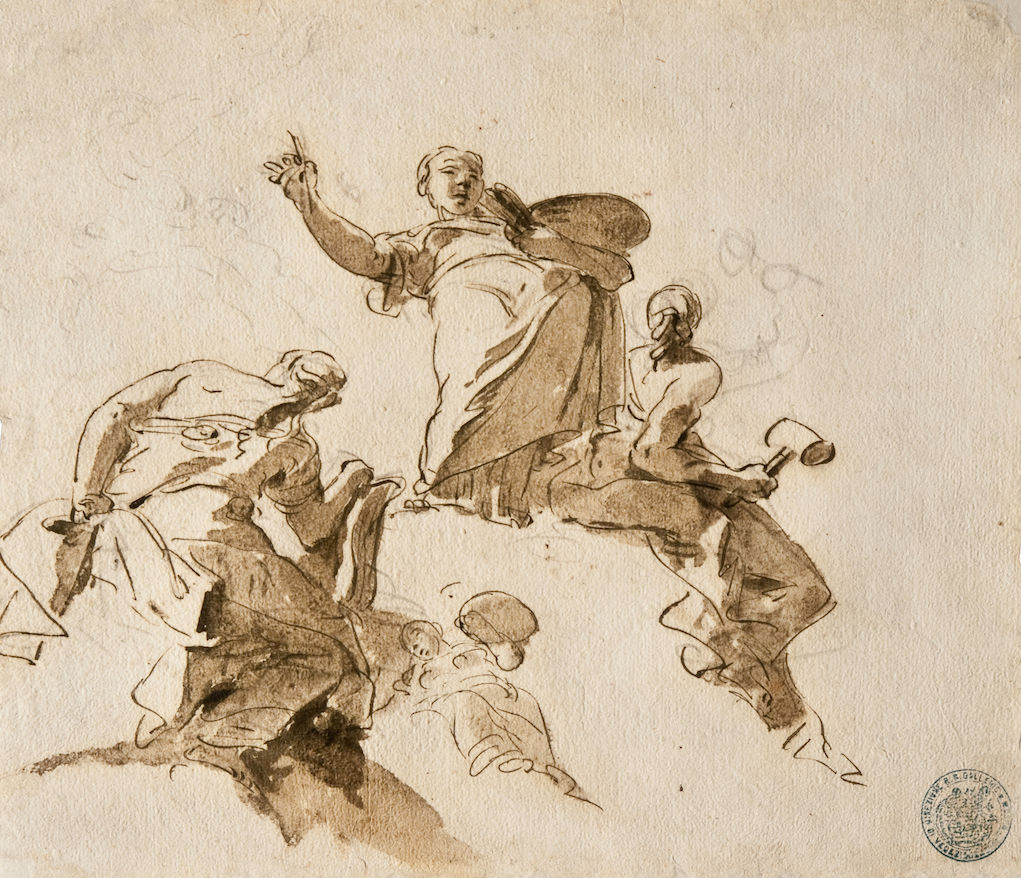A black and white photo of wisteria draping the courtyard walls welcomes visitors to the Frick’s current exhibit, Tiepolo in Milan: The Lost Frescoes of Palazzo Archinto, on view April 16 through July 14, 2019.
That wisteria survived the Allied bombing that took place August 13-16th, 1943, that tragically destroyed the Palazzo Archinto in Milan along with the magnificent Giambattista Tiepolo’s series of ceiling frescoes painted in 1730–31, his first significant project outside of Venice. During World War II, 65 percent of Milan’s historic monuments were damaged or destroyed.
Ironically, the show opened just hours before Notre Dame’s roof and spire were destroyed in a fire as crowds of stunned Parisians watched in horror in central Paris on that unforgettable day.
Famous for its singularly-focused exhibits, the Frick’s presentation shines light on objects that literally no longer exist, yet by uniting more than 50 works from collections in the U.S. and Europe, visitors will be able to understand much of the story behind this great loss.

Triumph of the Arts and Sciences (detail), ca. 1730–31 (destroyed 1943)
Archival photograph, 1940
6 3/4 x 4 3/8 inches
Azienda di Servizi alla Persona Golgi-Redaelli, Milan
Photo: Su autorizzazione dell’Azienda di Servizi alla Persona Golgi-Redaelli di Milano
Several complementary drawings and books illustrated by Tiepolo are also included, alongside documentary photographs, taken between 1897 and the early 1940s, which are the only surviving records of the finished frescoes. Fortunately, a number of black-and-white photographs were taken in Palazzo Archinto at different points before 1943.
In 1897, Attilio Centelli and Gerardo Molfese published a large volume dedicated to Tiepolo’s frescoes in Lombardy. The book includes a series of 50 photographs of frescoes by—or attributed at the time to—Tiepolo. Only three copies of the book survive (one in Milan, one in Rome, and one in Venice). Among them are preparatory works – paintings, drawings, prints and photographs – related to this magnificent commission on view for the first time.
The Allied bombing that was considered a last-ditch effort to rid Italy of lingering fascists, was comprised of 500 mainly British fighter planes that killed 1,000 human beings and destroyed five of Tiepolo’s most magnificent frescoed ceilings.
Palazzo Archinto belonged to one of Milan’s most prominent aristocratic families,
documented in the city since at least the 12th century. By the 18th century, the Archinto were described as one of those Milanese families who had always owned “highly admired treasures.”
Besides Tiepolo’s frescoes, the palazzo contained extensive collections of artworks and a renowned library. Tiepolo’s patron, Carlo Archinto (1670–1732), was at the center of Milan’s intellectual circles and recognized for his interest in philosophy, mathematics and science.
During the mid-18th century, he lived in the family palazzo, near Porta Ticinese, in one of the oldest parts of the city. The palazzo’s library, overseen by librarian Filippo Argelati, filled five rooms and was open to scholars. Together with Carlo Archinto and other patrons, he founded the Società Palatina, a publishing house.
The largest and most elaborate fresco at Palazzo Archinto was the Triumph of the Arts and Sciences, which decorated one of the main rooms on the palace’s principal floor, or piano nobile. In it, Tiepolo depicted a resplendent sky with an assembly of allegorical figures, including Architecture, Painting, Sculpture, Music, and Mathematics, under the aegis of Apollo and Minerva.
When Tiepolo created the sketch (modello) for the ceiling, the fictive architectural scheme (quadratura) that was to frame the fresco had not yet be finalized; he therefore depicted his figures hovering in a cloudy sky, surrounded only by an area of brown ocher. The quadratutista would later fill in the architectural details. The brown ocher areas are evident on several preparatory works.
What visitors can view are five preparatory paintings and drawings, among them the oil sketch Perseus and Andromeda, acquired by Henry Clay Frick in 1916. Since the Frick does not loan objects purchased by the institution’s founder, the New York museum is the only place where these works can be displayed together.

Study of Four Female Figures, ca. 1730–31 Pen, brown ink, and black chalk on white paper 11 3/8 × 13 3/8 inches
Civico Museo Sartorio, Trieste
Scholars and now laypersons will gain clues to the fresco of Perseus and Andromeda that was likely envisioned as a celebration of the wedding of Filippo Archinto and Giulia Borromeo, thus uniting two significant families.
The palazzo belonged to the Archinto family for more than a century, until 1825, when the family sold it. In 1853, it was purchased by the current owner, Luoghi Pii Elemosinieri, a charitable institution (now called the Azienda di Servizi alla Persona Golgi-Redaelli).
The Frick is located at 1 East 70th Street, near Fifth Avenue; it is open six days a week: 10:00 a.m. to 6:00 p.m. on Tuesdays through Saturdays; 11:00 a.m. to 5:00 p.m. on Sundays and is Closed Mondays. Children under ten are not admitted to the museum.












